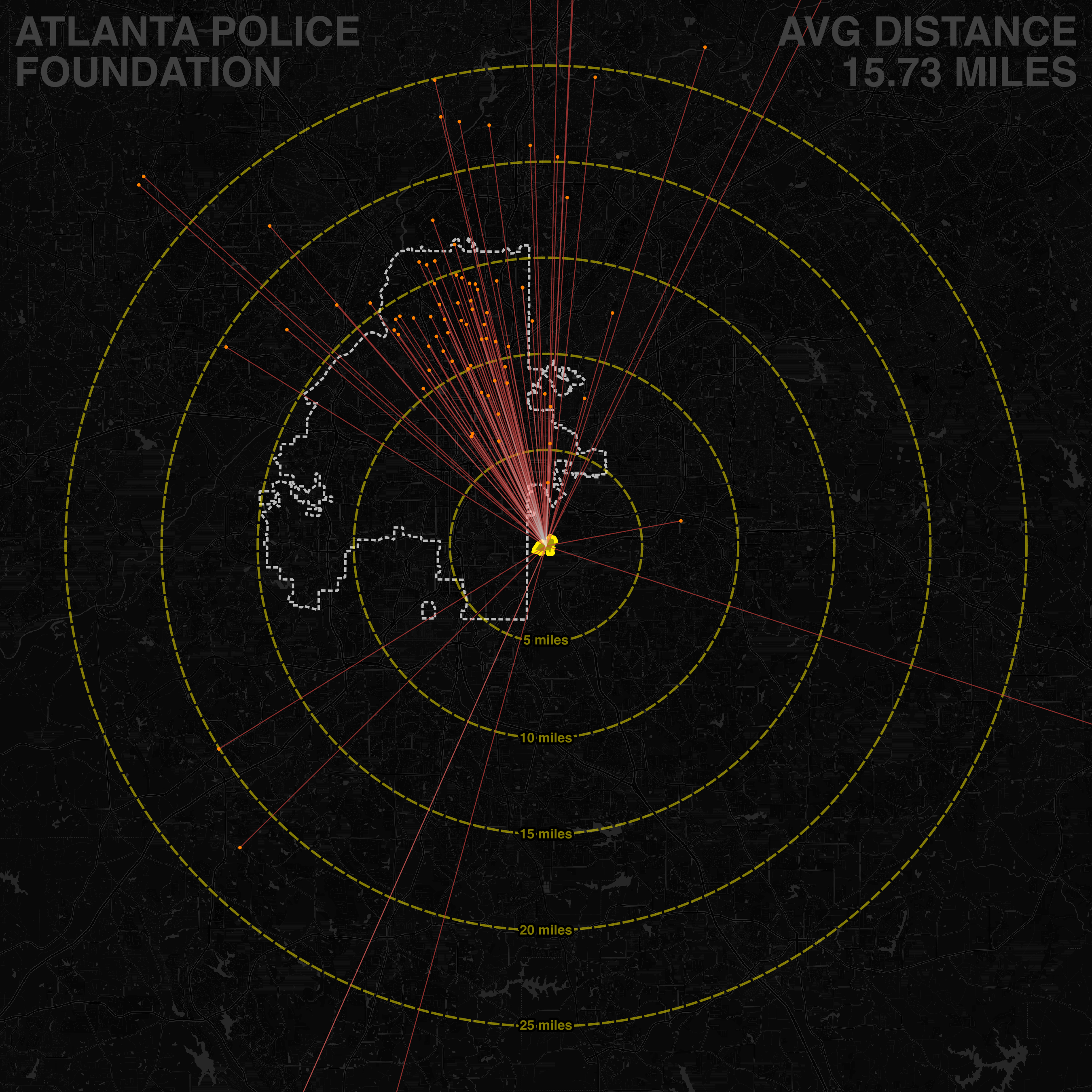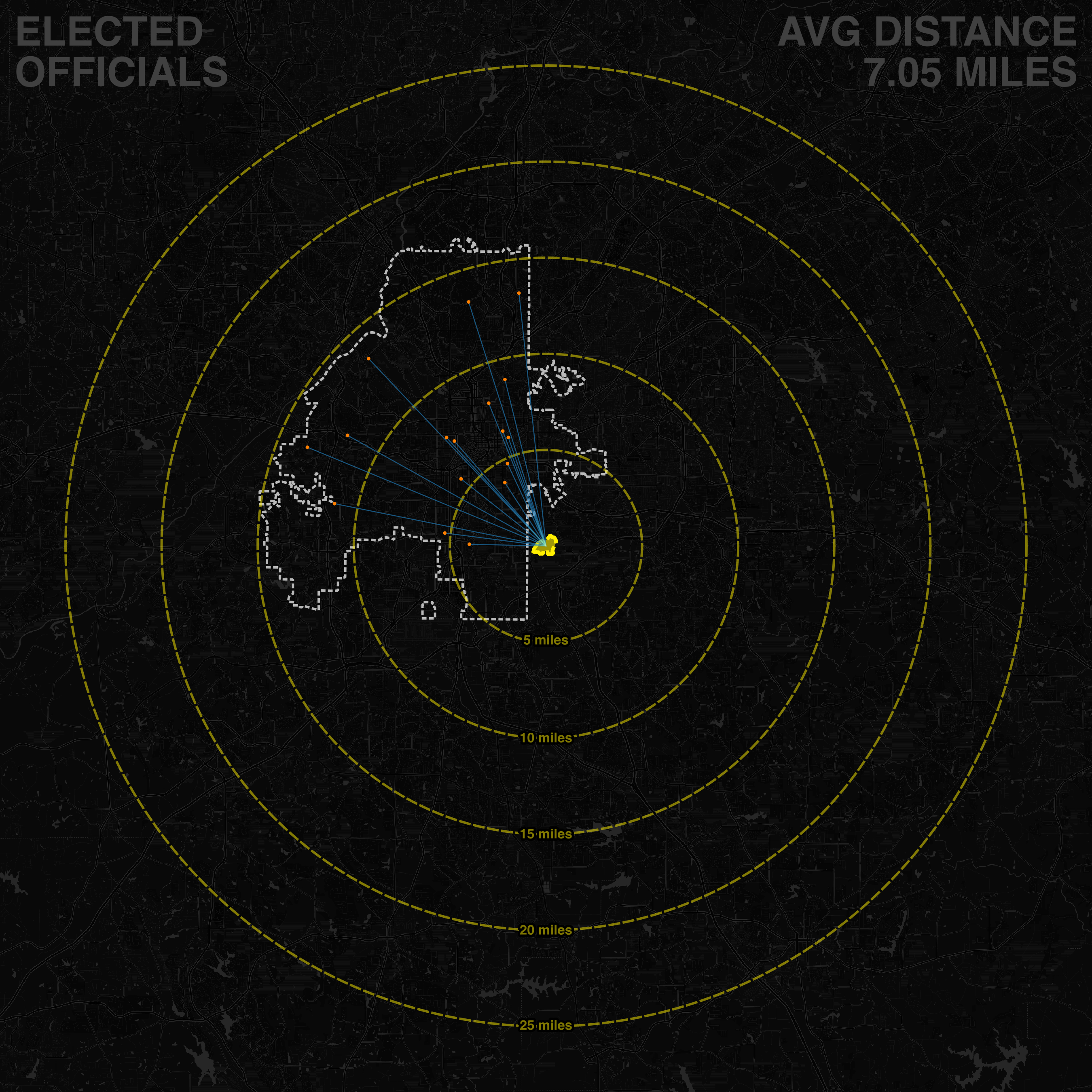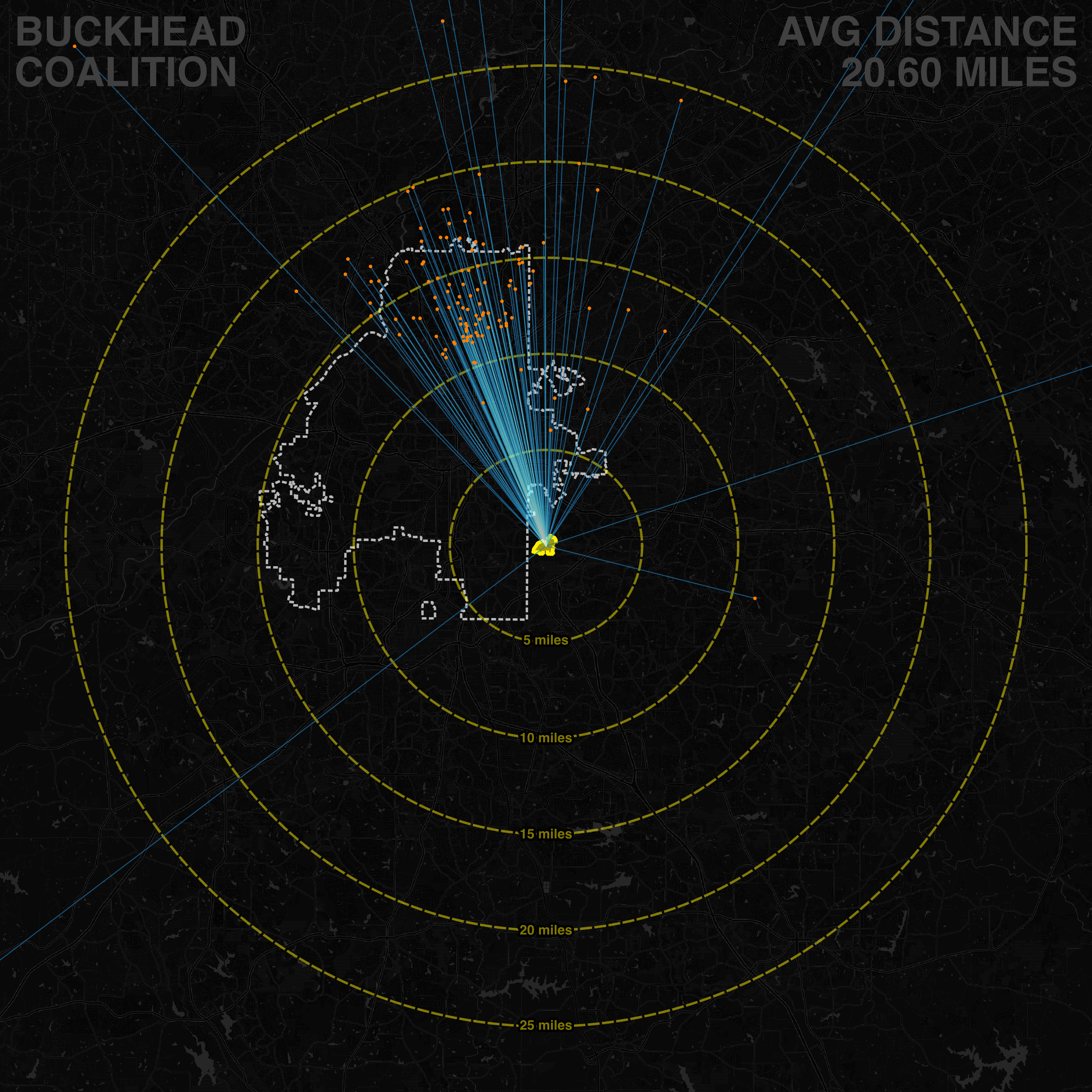For the last several months, the mayor, chief of police, state attorney general and local media have been at pains to paint the struggle to Stop Cop City as one comprised primarily of so-called “outside agitators”. A classic ploy of reactionaries seeking to maintain their power, the outside agitators narrative is meant to muddy the reality of intense local opposition to Cop City, as seen in both virtual and in-person public comment at council meetings, as well as in polling by Emory University political scientists.
In arguably the most definitive example of this genre when it comes to Cop City, the AJC’s chief in-house purveyor of nonsense not only called protestors “privileged, transient warriors”, but also decided to engage in a bit of bean counting, noting that of “a total of 48 people have been arrested…five were Georgians and three were Black”.[1] But for some reason, Bill Torpy and other Cop City apologists haven’t decided to apply that same logic to those who are responsible for forcing Cop City on us all in the first place. Indeed, if there are any outside agitators to be found in this struggle, they’re to be found among the project’s boosters.
With the help of my graduate student Ryan Pardue, we used a combination of publicly accessible property ownership records, voter registration data and online directory information to identify and map where the people responsible for Cop City actually live. Surprise, surprise! It isn’t anywhere close to the site in unincorporated south DeKalb where they’re proposing (and have already begun) to tear down hundreds of acres of forest in order to build a playground for the police. That is, the countless points made by the opposition about the negative effects of the project on the surrounding community can be easily ignored because the people pushing the project aren’t going to have to deal with the constant sounds of gunshots or increased flooding due to deforestation that are sure to come with it.

In our investigation, we’re particularly interested in four organizations that are at the center of Atlanta’s governing regime and the push to build Cop City: the city’s elected officials, the Atlanta Police Foundation board, the Atlanta Committee for Progress and the Buckhead Coalition. Perhaps accidentally, perhaps not, these institutions mirror the corporate, political and military interests at the heart of sociologist C. Wright Mills’ mid-20th century expose of the nation’s “power elite”. Regardless, they have been the primary institutional vehicles responsible for constructing the current panic around crime and policing in Atlanta, especially in the wake of the Black Lives Matter protests of 2020, and tend to be made up of representatives from Atlanta’s most powerful corporations and non-profits.
We’ve also added to our analysis the mayor’s recently announced “South River Forest and Public Safety Training Center Community Task Force”, which is officially responsible for representing Atlanta’s citizens when it comes to the planning for Cop City.[2] That being said, it’s important to recognize that the members of this task force aren’t really key players in the Atlanta power structure, but have been assembled together in order to launder the reputations of those who are under the guise of ‘community participation’. And so while these individuals tend to be somewhat more representative of the larger Atlanta community than the business leaders who are calling the shots, many of them nonetheless maintain close ties to these organizations and other powerful individuals.





Cumulatively we identified a total of 293 individuals listed as members of the organizations in question (in a number of cases individuals belong to more than one), and were able to identify likely home addresses for 291 of these. We then calculated the distances between them and the proposed site of Cop City in the Weelaunee Forest, as well as the average demographics of the neighborhoods in which these people live. While the geographic makeup of these different organizations’ membership exists along a spectrum, it is universally true that the people charged with pushing this project through are in no way representative of the community where the project is being sited, and in most cases aren’t representative of Atlanta in general. Given fact that (with the exception of elected officials) anywhere from 35-45% of these various organizations actually live outside of the city itself, there’s no way they could be representative of a place they aren’t even from!
One particularly salient example of such an outsider is Dave Wilkinson, the executive director of the Atlanta Police Foundation and arguably the primary individual driver behind Cop City, who lives basically a full hour outside the city in southern Fayette County. Wilkinson is hardly an outlier though, as the average individual in our dataset lives 25 miles away from proposed site, with the average distance for the Atlanta Committee for Progress being over 90 miles due to the number of non-local business representatives who sit on the board.
| All Orgs | Atlanta Police Foundation | Atlanta Committee for Progress | Buckhead Coalition | Community Task Force | Elected Officials | |
|---|---|---|---|---|---|---|
| Total Individuals | 291 | 87 | 34 | 124 | 41 | 17 |
| Within City of Atlanta | 184 (63.2%) | 52 (59.8%) | 19 (55.9%) | 74 (59.7%) | 27 (65.9%) | 17 (100%) |
| Within Buckhead | 117 (40.2%) | 39 (44.8%) | 8 (23.5%) | 71 (57.3%) | 2 (4.9%) | 2 (11.8%) |
| Within 5 miles | 13 (4.5%) | 1 (1.1%) | 1 (2.9%) | 0 (0%) | 8 (19.5%) | 3 (17.6%) |
| Within 10 miles | 67 (23%) | 15 (17.2%) | 11 (32.4%) | 5 (4.0%) | 25 (60.9%) | 11 (64.7%) |
| Within 15 miles | 196 (67.4%) | 54 (62%) | 20 (58.8%) | 76 (61.3%) | 33 (80.5%) | 17 (100%) |
| Within 20 miles | 244 (83.8%) | 64 (73.6%) | 28 (82.4%) | 109 (87.9%) | 36 (87.8%) | 17 (100%) |
| Within 25 miles | 257 (88.3%) | 74 (85.1%) | 28 (82.4%) | 112 (90.3%) | 37 (90.2%) | 17 (100%) |
| Within 50 miles | 281 (96.6%) | 84 (96.6%) | 30 (88.2%) | 120 (96.8%) | 41 (100%) | 17 (100%) |
| In Majority Black Census Tracts | 33 (11.3%) | 4 (4.6%) | 2[3] (5.9%) | 1 (0.8%) | 18 (43.9%) | 8 (47.1%) |
Of the 291 individuals we were able to map, less than a quarter live within 10 miles of the proposed Cop City site and only 13 live within five miles. The only individual who actually lives within a mile of the proposed site is Marc Bolden, president of the Boulder Walk Neighborhood Association and a media darling for those who want to further the outside agitator narrative. But Bolden himself is a newcomer to the neighborhood, having moved from Brookhaven in 2018 before being promptly installed as neighborhood association president by another pro-Cop City resident who has been instrumental in providing cover for the APF and city through her role on the original Community Stakeholder Advisory Committee. So even where the distance is smaller, the makeup of these organizations is still heavily tilted towards those who are otherwise connected to or dependent upon the larger power structure.
Beyond their sheer distance from the proposed site of Cop City, the vast majority of these individuals live in communities that are fundamentally different from the one they’re forcing this facility on. According to 2015-2019 American Community Survey data from the Census Bureau, the neighborhood surrounding the proposed Cop City site is over two-thirds Black, has a median household income of less than $45,000 (with over a third of residents living below the poverty line) and a median home value of less than $170,000. Meanwhile, the average member of the Atlanta power structure lives in a neighborhood that is just 20% Black, where the median household income exceeds $115,000 and the median home value is over $550,000. While these numbers are less stark for Atlanta’s elected officials and the members of the Community Task Force, they’re even more significant if you look at the members of the APF’s various advisory boards (especially if you exclude the members of their Young Executives Board, who are also a bit more geographically and demographically diverse than the rest of the organization’s leadership), the Atlanta Committee for Progress or the Buckhead Coalition, who live in even whiter and/or wealthier neighborhoods.
| Tract 238.02 | City of Atlanta | All Orgs | Atlanta Police Foundation | Atlanta Committee for Progress | Buckhead Coalition | Community Task Force | Elected Officials | |
|---|---|---|---|---|---|---|---|---|
| Average Median Household Income | $44,675 | $59,948 | $116,523 | $120,642 | $108,024 | $137,301 | $81,444 | $69,745 |
| Average Median Home Value | $168,800 | $290,400 | $553,568 | $565,779 | $519,088 | $693,388 | $303,395 | $290,565 |
| Average % Black Population | 67.5% | 51.0% | 20.0% | 15.4% | 13.4% | 9.4% | 48.6% | 56.7% |
In fact, even for those individuals who do happen to live within the Atlanta city limits, nearly two-thirds of them live in Buckhead, making them hardly representative of the city as a whole. And even though each of these entities have a number of Black members, with the exception of the Atlanta City Council and the Community Task Force, almost none of these Black folks live in Black neighborhoods. Indeed, more members of the Atlanta Police Foundation’s senior leadership live 50+ miles away from the Cop City site than live in majority Black neighborhoods around Atlanta. But these are apparently supposed to be people we should trust when it comes to doing what’s best for long-marginalized Black communities like those in unincorporated South DeKalb. These are neighborhoods that have never gotten the benefits of infrastructure improvements or political representation that could come with being annexed into the city proper, but which are now receiving all manner of new problems because of their exclusion from the city.
Considerable ink has been spilled dissecting “The Atlanta Way”, the name given to the practices of the city’s multiracial power structure that emerged in the mid-20th century. We’ve known that this power structure exists and how it operates. But it’s important to recognize that this power structure also has a spatial structure. It doesn’t take much to know that Buckhead runs the show around here, but these maps show that Atlanta’s power structure isn’t just based in what Dan Immergluck has called the city’s “favored northern quarter”. Indeed, a good portion of that power structure lies outside the city itself, stretching across the Atlanta metro, the state of Georgia and even further afield, accommodating regional, national, and global capital as much as its local counterparts. And yet these individuals and institutions choose to use that power to push more militarized police as the solution to practically every social problem, against the wishes of regular Atlanta residents.
So who are the real outside agitators after all?
[1] It has, of course, widely been documented that of the people initially detained by the police, nearly all of those with Atlanta or Georgia addresses were released specifically in order to cultivate this narrative.
[2] We made the choice, however, to leave out the “Community Stakeholder Advisory Committee”, due to the difficulty in knowing exactly who is on it, as well as the fact that the problems plaguing the CSAC were largely resolved through Dickens’ creation of the “Community Task Force” to replace it.
[3] The two members of the Atlanta Committee for Progress who live in majority Black census tracts are the two presidents of Spelman and Clark Atlanta University, who live in their universities’ respective on-campus presidential houses.

Leave a comment